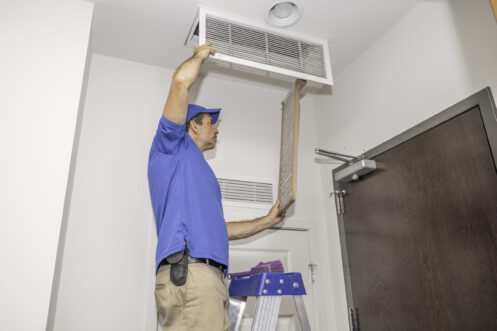
For the preservation of a healthy and comfortable living or working atmosphere, indoor air quality matters. The air that you breathe can be contaminated with different pollutants, allergens and other impurities, which can affect your respiratory system and contribute to several health complications. However, many types of air filters can help improve your indoor air quality, some of which we’ll go over below.
1. HEPA Filters
High-efficiency particulate air (HEPA) filters capture small particles and pollutants in the air. These filters are made from layers of fibers that trap particles when air passes through. A major attribute of these filters is their ability to capture particles as small as 0.3 microns with an efficiency rating of 99.97%. By taking advantage of mechanisms like diffusion, interception and impaction, HEPA filters are very efficient in eliminating common allergens like pollen, dust mites and mold spores, as well as microscopic particles such as bacteria and viruses. This makes them essential in areas where air quality is critical like hospitals, laboratories or cleanrooms. Additionally, the use of HEPA filters is common in residential air purifiers and vacuum cleaners designed to improve air quality and reduce symptoms of allergies, asthma and other respiratory issues.
Apart from their high filtration efficiency, HEPA filters are known for their durability and longevity. If used and maintained properly in a residential setting, HEPA filters tend to serve for several years without compromising the quality of air purification. However, you should stay away from using HEPA filters in your HVAC system unless it’s specifically designed for them, as they can restrict airflow and place strain on typical residential systems. Also, it’s worth mentioning that HEPA filters can’t remove gases, smoke, odors or volatile organic compounds (VOCs) from the air. Thus, for situations in which chemical pollutants are the issue, additional filtering systems may be required to attain total air purification.
2. Ultra Violet (UV) Air Filters
UV air filters use ultraviolet light to sterilize and disinfect the air by killing bacteria, viruses and other organic particles. These filters generally comprise UV lamps placed in an HVAC system or air purifier that emit UV-C light with wavelengths ranging from 200 to 280 nanometers. UV-C light is especially potent in disrupting the DNA and RNA of microorganisms to prevent reproduction, thereby making them harmless. UV filters are very effective in spaces that pose health risks due to airborne contaminants such as in residential homes.
However, UV air filters do not physically remove particles from your air. Unlike mechanical filters that retain particles, UV air filters actually target and kill microorganisms as they pass through. This makes UV filtration a perfect add-on to other forms of filtration, rendering biological contaminants inert before mechanical filters remove the particles from the air. In addition, UV air filters are eco-friendly and do not use chemicals, making them a non-toxic solution for improving indoor air quality.
Plus, UV filters are available in standalone units or in components you can add to your home’s HVAC system, giving you a range of options depending on your budget and what you want to achieve with them.
3. Washable Air Filters
Washable air filters, also known as reusable or permanent filters, offer an environmentally friendly alternative to disposables. Made from materials like foam, aluminum or electrostatically charged fibers, these filters can be washed and reused as many times as necessary, which is economical. By rinsing the filter with running water or using a vacuum cleaner, dirt and debris accumulated on it can be removed, which helps to restore filtration efficiency. Washable filters are appropriate for areas with medium levels of airborne contaminants, as they can provide long-term cost savings over disposables. Nevertheless, their filtration efficiency is generally not as high as that of HEPA or pleated filters. Hence, they are unsuitable for environments where there is an immediate need for high-level air purification.
Also, many standalone air purifiers contain washable types of air filters, which may be different from the type you’d purchase for use in place of a central HVAC system’s filter. It’s a good idea to check your system’s documentation to make sure of which types of washable filters are suited for use with it.
4. Activated Carbon Filters
Carbon filters are very effective in removing odors, gases and VOCs that cause air pollution in your space. They consist of activated carbon, a porous material produced from charcoal, wood or other organic sources that goes through a process called activation, which increases its surface area and pore size. Activated carbon has microscopic pores that provide a large surface area whereby molecules of different pollutants are absorbed and trapped as air passes through.
The versatility of these filters in dealing with various air contaminants is one major benefit. They are also capable of neutralizing cooking, pet and tobacco smoke odors as well as gases released by cleaning products, paints and building materials. Besides, activated carbon filters are often used together with other filtration systems like HEPA filters in order to address both particulate matter and gaseous pollutants.
However, it’s hard to estimate how long activated carbon filters can last, as it largely depends on how much they filter out. You’ll have to replace them more often in places with more pollutants, as the charcoal pores fill up with the molecules they trap, decreasing their absorption capacity. The best way to tell if it’s time for a replacement is to use your nose: if odors start to come back, it’s time for a new filter.
5. Pleated Filters
Pleated filters have a design that looks like an accordion. They are made from different materials like synthetic fiber, cotton and polyester, woven together to catch contaminants from the air that flows through the filter. In addition, they have different MERV (Minimum Efficiency Reporting Value) ratings, which signify what they can remove from the air. The higher the MERV rating, the more types of particulates a filter can remove from the air. Generally speaking, pleated filters are commonly found in central HVAC systems.
The choice of an appropriate air filter depends on a number of factors such as concerns about the quality of air, filtration needs, budget limitations and personal preferences. Although each type of air filter has unique benefits and applications, the ultimate objective is to achieve a healthier and more comfortable indoor space by reducing airborne pollutants and allergens. By familiarizing yourself with the strengths and weaknesses of various air filtration technologies, you can make wise decisions to protect your health and ensure cleaner air in your residential or commercial setting.
Get in Touch With the Professionals
Are you tired of breathing polluted air? Take control of your indoor atmosphere by opting for better air filters. Whether you require HEPA for allergens, activated carbon for odors or UV for microbial control, there’s a solution for you. At Beyer Air Conditioning & Heating, we have a team of licensed and certified technicians who can advise you on the right air filter based on your needs. We also offer heating and cooling services to residents in San Antonio and the surrounding areas. Therefore, don’t hesitate to contact us at Beyer Air Conditioning & Heating for a consultation or to schedule an appointment today!



